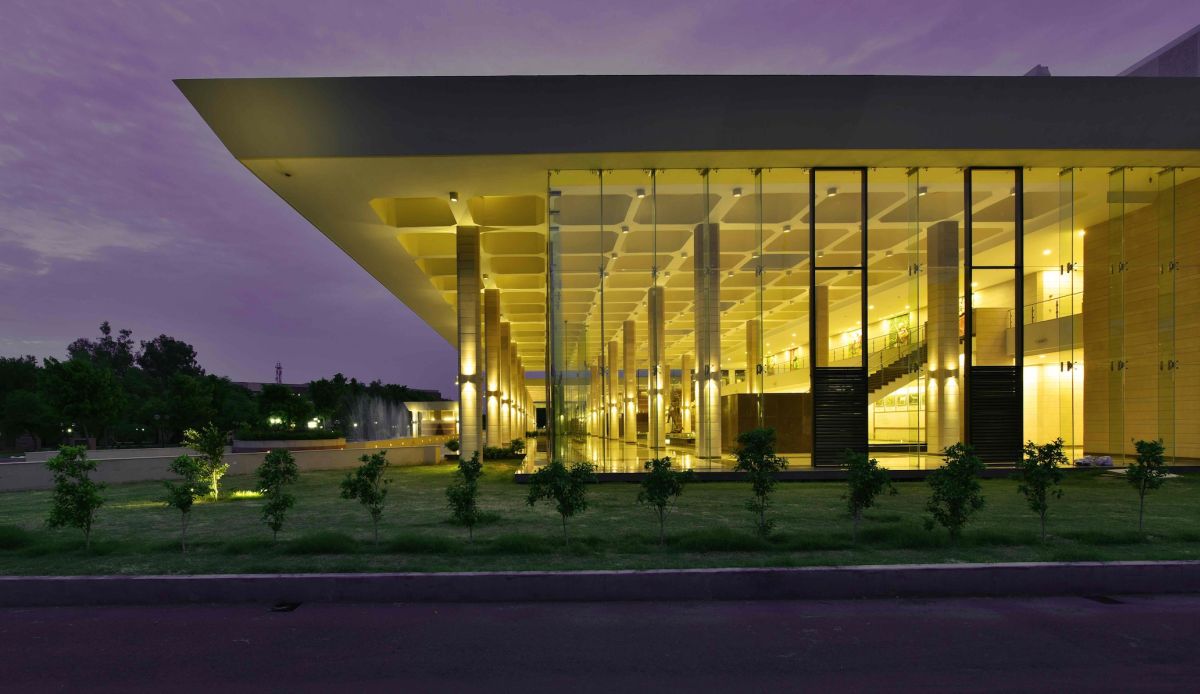DESIGN PHILOSOPHY:
The client had requested for two state-of-the-art Auditoriums (1000 and 300 capacity) which would rival any professional auditorium and would be the premier institutional auditoriums in the country. We decided to take up this challenge and use the site conditions as our starting point.
 We were fortunate to have been given a site which was near the main entry of the 265 acre educational campus with almost the entire campus being seen from the approach road. We therefore decided to orient the main foyers of both the auditoriums facing the approach road and overlooking the well maintained “green” campus. Since this orientation also gave us the advantage of using the North side, we took the calculated risk of having a fully glazed façade enveloping the foyers. Though this aided the outlook from the foyers, it posed a challenge in controlling the heat gain, especially in the extreme summers. To address this issue, we inter-spaced the glass façade with louvered panels to get in fresh-air. Water-bodies planned in front of these foyers helped cool this air. The foyer roofs were then designed with raised skylights with louvers all around. This helped create a “stack-effect” and aided natural cross-ventilation. The skylights also helped get natural light into the interiors thus reducing the dependency on artificial lighting. Post occupation, the clients were happy and relieved to find that compared to the other buildings on the campus, the interiors here were more comfortable during summers.
We were fortunate to have been given a site which was near the main entry of the 265 acre educational campus with almost the entire campus being seen from the approach road. We therefore decided to orient the main foyers of both the auditoriums facing the approach road and overlooking the well maintained “green” campus. Since this orientation also gave us the advantage of using the North side, we took the calculated risk of having a fully glazed façade enveloping the foyers. Though this aided the outlook from the foyers, it posed a challenge in controlling the heat gain, especially in the extreme summers. To address this issue, we inter-spaced the glass façade with louvered panels to get in fresh-air. Water-bodies planned in front of these foyers helped cool this air. The foyer roofs were then designed with raised skylights with louvers all around. This helped create a “stack-effect” and aided natural cross-ventilation. The skylights also helped get natural light into the interiors thus reducing the dependency on artificial lighting. Post occupation, the clients were happy and relieved to find that compared to the other buildings on the campus, the interiors here were more comfortable during summers.
Auditoriums usually have a lot of scope for display of artifacts due to large blank walls which naturally form due to the inherent requirements of the design. We were fortunate that the client also shared our passion for arts and was most enthusiastic to have numerous art works installed in the foyers of both auditoriums.
Being institutional auditoriums, we realized that maintenance and repairs would be a difficult task for the management. We have therefore designed most of the seating area interiors with resilient finishes like polished granite and aluminum panels. Profiling and manufacturing these materials to suit the exacting acoustic requirements was a challenge which we managed after some R & D along with our acoustical consultant.
A 200 seater Cafeteria has also been designed on similar principles and completes the development along the approach road.
MAIN AUDITORIUM
-
Expansive stage area with elaborate facilities for multiuse.
Main, mid and rear curtains provided to enable stage division as per event requirement. -
Elaborate rigging system with provision for flying scenery, presentation screen, cinema screen, scenery, backdrops, hanging mikes, chandelier, and multiple options for stage lighting. Multi-level dressing rooms for single and group occupancy with attached toilets.
Quick change rooms provided in side stage area for easy access. -
Side walls of Seating area have artworks of Ancient Indian Instruments.
-
Entrance and side foyers embellished with numerous artworks like Bronze Nataraj Statue, murals of Pradosh Nritya and Raas-leela, relief works of Indian musicians and artists.
-
Foyers designed so as to be “one-with-nature”. Hence, the double height entrance foyer is enveloped with a full glass façade, thus blurring the line between the “Inside” and “Outside”. Temperature control and cross ventilation in the foyers is facilitated by having louvres in the glass façade and ventilators below the roof skylights.
-
State of the Art Audio Video equipment installed: Cinema quality projector from Christie, audio system from Bose, and Senheisser microphones.
Capacity: 1040
MINI AUDITORIUM
-
This Auditorium was designed mainly for seminars, presentations and placement interactions.
-
Seating Layout designed such that it envelops the stage from 3 sides.
This arrangement is especially designed for better interaction between the stage occupants and the audience, and also for intra-audience interaction. -
Entrance and side foyers embellished with numerous artworks like the Sun Mural and Indian Dance Forms.
-
Foyers designed so as to be “one-with-nature”. Hence, the double height entrance foyer is enveloped with a full glass façade, thus blurring the line between the “Inside” and “Outside”. Temperature control and cross ventilation in the foyers is facilitated by having louvres in the glass façade and ventilators below the roof skylights.
-
State of the Art Audio Video equipment installed: Cinema quality projector from Christie, audio system from Bose, and Senheisser microphones.
Capacity: 303
Cafeteria
Project Facts:
Architect & Principal Consultant : Architect Rahul Manohar of RMM Designs / www.rmm–designs.com
Structural Consultants : Sterling Engineering Consultancy Services Pvt Ltd
MEP Consultants : Design Bureau Consultants Pvt Ltd
Acoustical Consultant : Dr. S Rajagopalan
Photography: Prashant Bhat
- Scope of Work: All disciplines including building design, interiors and landscaping.
- Completion: 2016
- Location: Lakshmangarh near Jaipur, Rajasthan



















